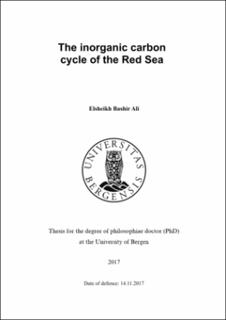| dc.contributor.author | Ali, Elsheikh Bashir | |
| dc.date.accessioned | 2017-11-20T12:37:36Z | |
| dc.date.available | 2017-11-20T12:37:36Z | |
| dc.date.issued | 2017-11-14 | |
| dc.identifier.uri | https://hdl.handle.net/1956/16944 | |
| dc.description.abstract | The aim of this thesis has been to improve the general scientific understanding of the marine inorganic carbon cycle of the Red Sea. The region houses an exceptional range of ecosystems and it is considered the most important repository of biodiversity in the world with vast calcification areas rich in coral reefs. Therefore, it is important to understand the interaction between biogeochemical processes and the Red Sea ecosystem. In spite of this fact, the area is poorly studied, and this is particularly true for the marine inorganic carbon cycle. Prior to this work, no systematic sampling of biogeochemical variables had been done off the coast of Sudan. As part of this work, a new biogeochemical time series from the Sudanese coastal waters has been established, which represents the very first data on hydrography and inorganic carbon from this part of the Red Sea. The sampling site has been operated since 2007, and here is presented data over a period of 8 years, from 2007 to 2015. Consequently, there now exists a comprehensive dataset allowing the quantification of interannual to seasonal variations in biogeochemical variables, and identify important processes that control these changes. The establishment of such a baseline is important to compare future changes caused by climate and environmental changes when approaching the high CO2 world. The three papers in this thesis improve and renew our understanding of the Red Sea hydrography, the inorganic carbon cycle, how the variation goes, and what drives the observed changes. A common assumption has been that the temperature and salinity variations in the Red Sea is solely a function of local heat and mass flux. However, results from the current work evidence that advection of temperature and salinity gradients also plays a role for establishing the temperature and salinity maxima in the area (Paper I). The finding of this paper also show that the annual temperature range is approximately 6°C, with highest temperatures during summer and autumn. Changes in salinity lag that of temperature with about 3 months. The inorganic carbonate measurements (Paper II) document for the very first time the seasonal as well as interannual variability of dissolved inorganic carbon (DIC) and total alkalinity (AT) in this part of the ocean. This pristine dataset has been used to construct a baseline for the inorganic carbon cycle and constitutes an important reference for years to come. Higher AT and DIC is measured during winter compared to the summer with an annual change of approximately 40 μmol kg-1 for AT and 32 μmol kg-1 for DIC. AT is mainly driven by physical processes such as advection and local evaporation (through salinity changes) as well as calcification, while changes in DIC are mainly a result of air-sea exchange and likely biological activity, and to a smaller degree along shore advection. The Red Sea, which is situated in the sub-tropical and tropical area, has previously been regarded as a net annual source for atmospheric CO2, but this view has to be revised. Paper III shows that pCO2 is high during summer and autumn and low during spring and winter, with a seasonal amplitude of about 60 μatm. Consequently, the Sudanese coastal area acts as a source for atmospheric CO2 during summer and autumn, while during winter and spring, the area is a sink for atmospheric CO2. Over an annual cycle, the area is a net sink of atmospheric CO2 of size 24.4 mmol CO2 m-2 y-1. The change from being a net annual source for atmospheric CO2 to becoming a net sink likely occurred in the 2000s. | en_US |
| dc.language.iso | eng | eng |
| dc.publisher | The University of Bergen | en_US |
| dc.relation.haspart | Paper I: Ali, E. B., J. H. Churchill, K. Barthel, I. Skjelvan, A. M. Omar, T. E. de Lange, and E. B. A. Eltaib, 2017. Seasonal and interannual variations of hydrographic parameters in the Sudanese coast of the Red Sea, 2009-2015. The manuscript is available in the main thesis. The article is also available at: <a href="https://doi.org/10.1016/j.rsma.2017.12.004" target="blank">https://doi.org/10.1016/j.rsma.2017.12.004</a> | en_US |
| dc.relation.haspart | Paper II: Ali, E. B., A. M. Omar, I. Skjelvan, and T. Johannessen, 2017. Dissolved inorganic carbon and total alkalinity at the Sudanese coastal Red Sea, 2009-2013. The manuscript is available in the main thesis. | en_US |
| dc.relation.haspart | Paper III: Ali, E. B., I. Skjelvan, A. M. Omar, A. Olsen, T. E. de Lange, T. Johannessen, S. Elageed, 2017, Sea surface pCO2 variability and air sea gas exchange in the coastal Sudanese Red Sea. The manuscript is available in the main thesis. | en_US |
| dc.title | The inorganic carbon cycle of the Red Sea | en_US |
| dc.type | Doctoral thesis | |
| dc.rights.holder | Copyright the Author. All rights reserved | en_US |
| dc.identifier.cristin | 1513773 | |
